The top 5 trends for the agrifood industry in 2021
Here are the top European food trends for 2021:
After a year of change like no other in 2020, EIT Food has combined expert insights and analysis to highlight the top 5 trends for the agrifood industry in 2021...
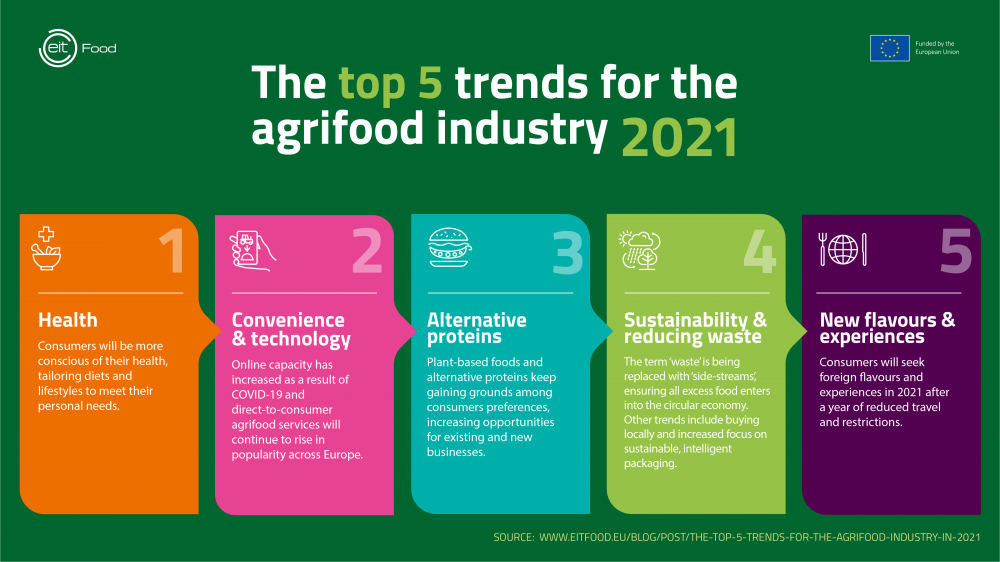
Want to learn more about the top European food trends for 2022? Go here!
Looking beyond the COVID-19 pandemic is a difficult prospect considering its ongoing impacts across the world, requiring us all to quickly innovate and adapt to a new reality. The agrifood industry was put under huge pressure in 2020 and businesses across Europe and globally are still fighting the crisis in new ways. One thing that is certain, however, is that COVID-19 is leaving behind new trends and consumer preferences and priorities as we progress into 2021.
In a recent Food Fight podcast episode (2), Food and Drink Analyst Edward Bergen from global research body Mintel, and Manager of EIT Food’s RisingFoodStars Association, Annick Verween, shed light on some of these short- and long-term impacts of the pandemic and discussed new trends from across the entire food value chain. “The agrifood sector was the main sector that suddenly needed to be protected,” Annick said. “For a lot of startups and scaleups, this opened new opportunities to have clear visibility and to do things more transparently, healthily and sustainably.”
1. Consumers will focus more on their health
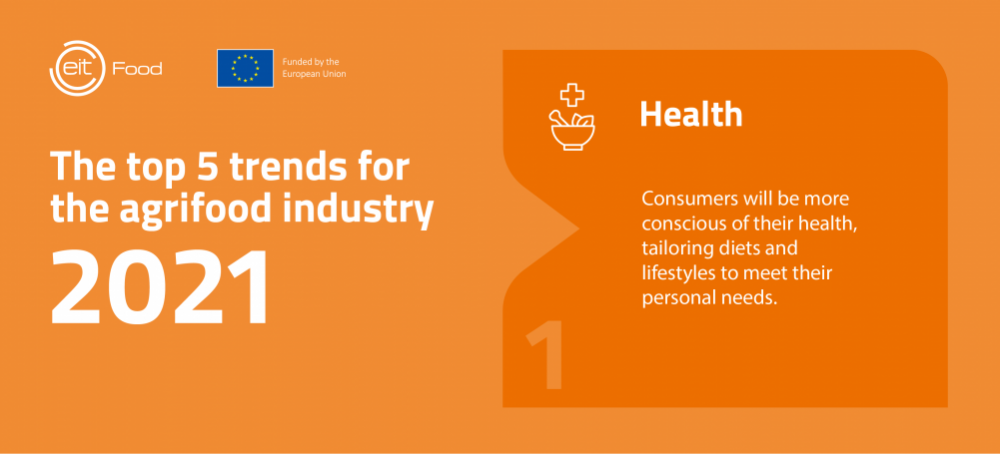
The first top trend is an increased focus on health and wellbeing, whether it be due to people having more time at home during lockdowns or amid fears of falling ill (3). This is a trend that has been seen across Europe and is predicted to continue even after the pandemic subsides (1).
In the podcast episode, Edward explained that consumers are more aware of their health and will think more long-term when it comes to their personal wellbeing in 2021. He pointed to the “fight back against mental health” (2), as seen in Mintel’s Global Food and Drink Trends 2030 report (4), as a key trend.
The report states that people are modifying their diets and lifestyles to improve the health of their brain, states of mind and moods. “I think balance will come back into focus where people will think about not only their long-term health, but at the same time want indulgent brands and new claims related to brain health and relaxation,” Edward said. This suggests that future agrifood products and services will benefit from focusing on a ‘balance’ of health and wellbeing, as well as comfort and relaxation.
Personalised nutrition
The drive for personalised nutrition to improve both physical and mental health is a key focus area for EIT Food. LOEWI, one of EIT Food’s RisingFoodStars based in Germany, is an example of how innovations in our community are within the personalised nutrition space and are continuing to grow. Using regularly updated scientific studies, LOEWI offers its customers personalised supplements based on high-quality blood diagnostics and lifestyle data, ensuring that results are transparent and trackable.
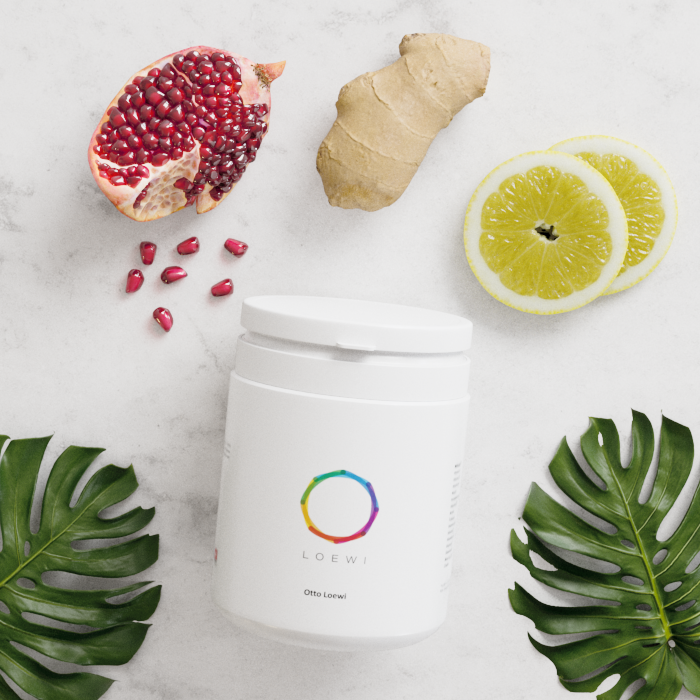
Annick predicts that more companies like this will emerge in 2021. “There's a lot of [people] asking now about what enhances immunity and these companies are helping to clarify the added value of health claims, which are often confusing for consumers,” she said (2).
This is not a new trend, but the COVID-19 pandemic has provoked an upward trajectory of people wanting to stay fit and healthy, with almost half of consumers (49%) who participated in EIT Food and Aarhus University’s recent consumer behaviour study saying that being in good health will be more important to them as a result of COVID-19 (1). This presents the industry with a “real opportunity to innovate to meet consumer needs,” said Professor Klaus Grunert, Head of Section of the Department of Management at Aarhus University, the study lead (1), and for consumers to become active changemakers in shaping the future of food.
Trusting in science and safety
Edward added that, “I think we're going to be more trusting in science in 2021; the vaccines are going to help consumers trust in new methods of production.” He highlighted that brands are starting to use ‘sanitary theatre’ or ‘safety theatre’ in their marketing to display the cleanliness of their products. For example, Edward suggested that more brands will begin to convey that their products have been well washed and that their staff are wearing the appropriate PPE. “This could help certain new products come to market, such as lab-grown foods, where they can state ‘this is in fact a cleaner method of production,’ for example,” he said.
2. Convenience and technology will accelerate
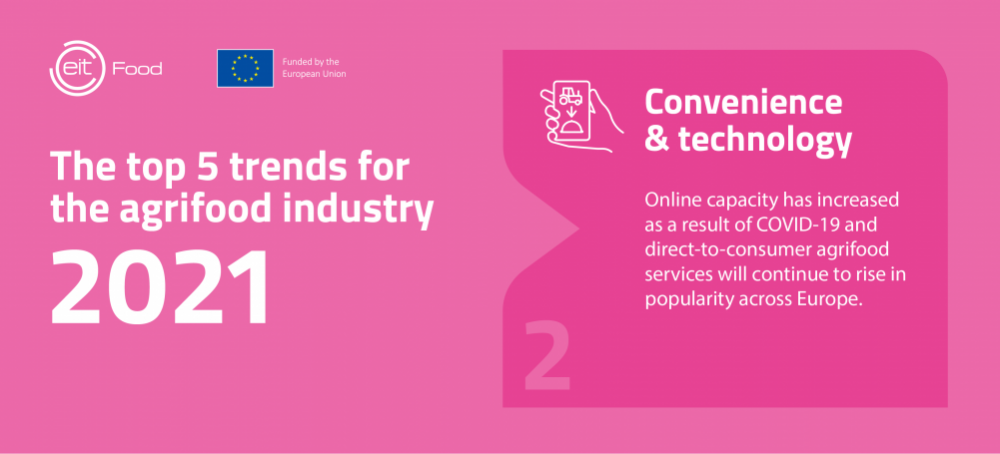
As seen in the EIT Food community through skyrocketing online course enrolments and greater digital engagement in 2020, it is clear that there has been a huge boost in online capability, which is why convenience and technology is another top trend.
One of the most prevalent examples is online food shopping and direct-to-consumer services. Traditional methods of sourcing food have been digitalised as a result of the pandemic and more people are using them. The consumer behaviour study revealed that the largest behavioural shift was in fact the way Europeans are shopping, with nearly half reporting an increase in online shopping (45%); bulk purchases (47%); and carefully planned shopping trips (45%) (1).
This is supported by the findings in the EIT Food Strategic Foresight Analysis on how COVID-19 has affected agrifood systems in South and Central Eastern Europe (5). The analysis maps out future paths for the agrifood industry based on different scenarios and found that the pandemic's impact on supply chains increased direct-to-consumer initiatives in the industry, such as sales channels being developed to sell surplus stock directly from farmers to consumers. It suggested that these could continue in 2021 if the disruption of supply chains continues and that businesses should be well prepared for this.
This correlates with the upward trend in providing traceability from suppliers and the demand for complete transparency from consumers. The digitalisation of services will be a necessary development in the food supply system as traceability and transparency become crucial to consumer purchasing decisions, and expectations on health, worker conditions, human rights, animal welfare and sustainability continue to emerge as important priorities (6).
Home cooking
Another key finding of the consumer behaviour study was the rise in home cooking, with over a third (36%) of people reporting that they have enjoyed spending time cooking during lockdown (1). “Consumers have told us they have spent more time cooking and that they're going to do more [in 2021]; particularly very young consumers aged 16-19 who cooked for the first time ever in some cases,” Edward said (2). In the podcast, Edward and Annick explained that this has prompted the rise of ‘smart kitchens’ where people are relying more on products and devices that can cook things in new ways, creating an opportunity for new kitchen-based technology solutions.
But how far could a ‘smart kitchen’ go in 2021? What about 3D printing food at home, for example? “I think there is definitely an opportunity for that market,” Annick said (2). “But it will take a while. It will first go to places such as hospitals to create easy-to-swallow foods with better nutrition for example, and then it will likely become mainstream after that. A lot of us still think about 3D printing as something more mechanical as opposed to creating food that we actually eat.”
At EIT Food, we support a number of startups and scaleups working in the 3D printed food market as a sustainable, convenient alternative to food production, such as Natural Machines who have developed the ‘Foodini’ 3D food printer, and NOVAMEAT, the creators of the world’s first 3D printed beef steak.

High-tech harvests
Another trend in the tech space predicted to accelerate is the acceptance of new ways to produce food. According to Edward, this trend is not necessarily about new innovations themselves, but on how consumers value and accept agrifood technology used in production.
“We were a bit scared of too much science in our food,” Edward said (2), reiterating that consumers are perhaps a bit more accepting of scientific or ‘artificial’ production methods after 2020. “A great example is a farm under a London underground station. You don't need to tamper with the actual seeds or ingredients - you can just change the lighting to actually shift how a product grows,” he explained, suggesting that changing consumer perceptions of alternative methods of production such as vertical farming could see new innovations coming to light in 2021 and entering into mainstream markets.
3. Alternative proteins continue to gain grounds with consumers
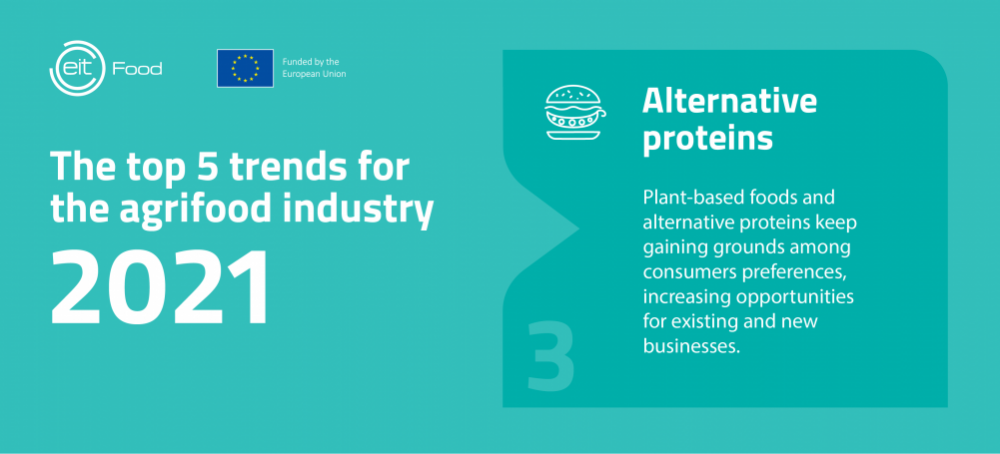
The alternative proteins market is an example where consumer acceptance is already growing across the world. At the end of 2020, the news that Singapore had approved the world’s first lab-grown chicken meat to be sold to the public (7) was a breakthrough for the market. In Europe, the EU’s Farm to Fork Strategy is also advocating for plant-based diets as a way to improve both physical and environmental health (8).
“Alternative proteins are even more important now than they already were. What’s happened in Singapore is going to change things at a huge pace,” Annick said (2). Within the EIT Food community, alternative proteins is a key area that is continuing to expand. In our RisingFoodStars Association, for example, Mosa Meat, a Dutch scaleup which produces beef directly from animal cells, recently closed its $75 million series B round.
This is supported by the fact that 2019’s largest agrifood technology funding round outside of the US was received by Paris-based Ÿnsect, an alternative protein insect breeding startup (9). What’s more, in January 2021 the European Food Safety Authority (EFSA) published a scientific opinion about dried yellow mealworms as a novel food, deeming them safe for human consumption (10). This could pave the way for the market in 2021 and lead to further insect-based products appearing on supermarket shelves.
Annick also highlighted mycoproteins and alternative proteins from waste streams as big trends to look out for. “This is maybe an even more exciting trend because it's more than just making a plant-based protein, it's also using something that is otherwise thrown away. I think it is extra exciting if we can really close the circle fully,” she said (2).

4. Sustainability and waste reduction will become increasingly important
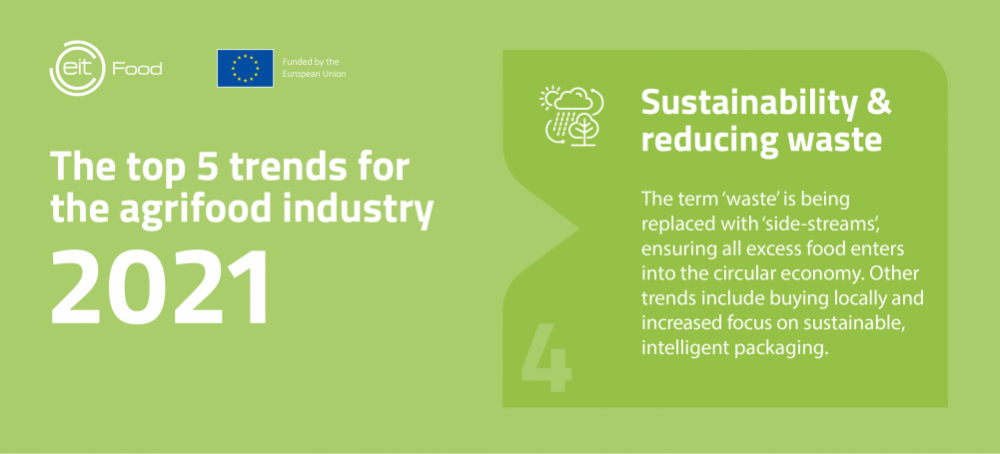
‘Closing the circle’ and waste reduction have been on the radar for some time, but with the FAO announcing that 2021 will be the International Year of Fruits and Vegetables (IYFV) to improve healthy and sustainable food production and to reduce food loss and waste (11), this is a trend we predict to become even more important.
Protecting the planet with informed food choices
In a 2020 Accenture report, it was reported that 60% of people were making more sustainable and ethical purchases since the start of COVID-19, with nine out of 10 likely to continue doing so after the pandemic (12).
This is an important trend which has been accelerated by consumers’ understanding that some healthy ingredients are also better for the planet than others, Edward said (2). An example is the chickpea, which he explained can not only be used in various different ways as an ingredient, but also feeds the soil while it grows without using a huge amount of water. “I think that we're going to see more brands celebrating these types of ingredients. In the past, it was about saying ‘this ingredient tastes nice’, but now it's about saying, ‘they taste amazing but they’re also great for the planet.’” (2)
This is also predicted to become more important for consumers themselves. “We've got a trend this year called 'Quality Redefine’ which talks about what quality means to the consumer,” Edward noted (2). He said that price is, of course, important, but food that comes with a story about how the farmer is paid and respected, or how the environment it grows in is treated, for example, is only going to become more and more popular. Buying sustainably and locally was another key finding of the EIT Food European consumer behaviour study, which revealed that over a third of people consider buying locally produced food important as a result of COVID-19 with 87% of those likely to continue after the pandemic (1).
Sustainable packaging
“We are also seeing more companies who are really focusing a lot on packaging. We as consumers want to buy something that we can keep for a while before we use it, and there are a lot of great startups who make compostable packaging doing pilots with big corporates,” Annick said (2). TIPA is an example of a business in the EIT Food community that is developing plant-based, compostable flexible packaging solutions. TIPA’s mission is for its packaging to have the same end-of-life as organic matter while maintaining the qualities of conventional plastics.
This will be fitting for 2021’s trends, considering over a third of European consumers reported an increased preference for pre-packaged goods due to hygiene concerns as a result of COVID-19, with 29% more people seeking biodegradable or recyclable packaging for their food (1).

5. Consumers will seek new flavours and experiences
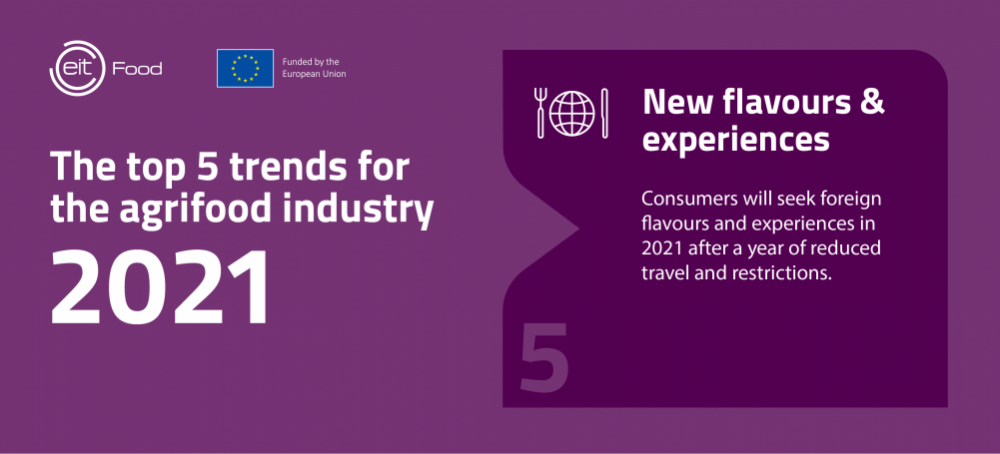
The final agrifood industry trend in our top five list is the growing appetite for new food experiences. After a year of reduced travel and restrictions, consumers will be seeking to expand their palates and try new things. As Edward said in the podcast episode, “food tourism is a big thing” (2), but the return of travel as we know it is still in question. Because of this, Edward suggested that new flavours and experiences will come closer to home.
With restaurants across Europe being forced to close or run at reduced capacity, food brands might benefit from expanding their offerings to include foreign ingredients and styles that people can cook at home. This is supported by the rise of smart kitchens, where people are expanding their palates and kitchen capabilities beyond the norm.
EIT Food in 2021
Trends are what drive the agrifood industry and it has never been more important to follow the voice of the consumer. EIT Food is committed to building an inclusive community of agrifood stakeholders, promoting collaboration as the key to transforming the food system with consumers at the core. If you are interested in joining the EIT Food community and following these top five trends, subscribe to our Food Fight podcast and find out how you can get involved.
Further reading
- Reuters: Will 2021 be the year of living sustainably for Europe?
- Mintel: How COVID-19 accelerated the 2030 Food & Drink Trends
- BBC: Has coronavirus made us more ethical consumers?
References
- EIT Food: EIT Food report reveals lasting impacts of COVID-19 pandemic on European food behaviours
- EIT Food: The Food Fight podcast: Forecasting the future: the biggest agrifood trends for 2021
- The Guardian: ‘I got a whole new mindset’: the health secrets of people who got much fitter in lockdown
- Mintel: How COVID-19 accelerated the 2030 Food & Drinks Trends
- EIT Food: Foresight on the impact of COVID-19
- Tasting the Future: Covid 19 is accelerating food sustainability trends: eight to watch
- BBC: Singapore approves lab-grown ‘chicken’ meat
- European Commission: Farm to Fork Strategy
- AgFunder: 2020 European Agri-FoodTech Investment Report
- European Food Safety Authority (EFSA): Safety of dried yellow mealworm (Tenebrio molitor larva) as a novel food pursuant to Regulation (EU) 2015/2283
- FAO: FAO launches the UN’s International Year of Fruits and Vegetables 2021
- BBC: Has coronavirus made us more ethical consumers?
More blog posts

Think Tank BLOG: Plant-based meat – from boom to business reality









